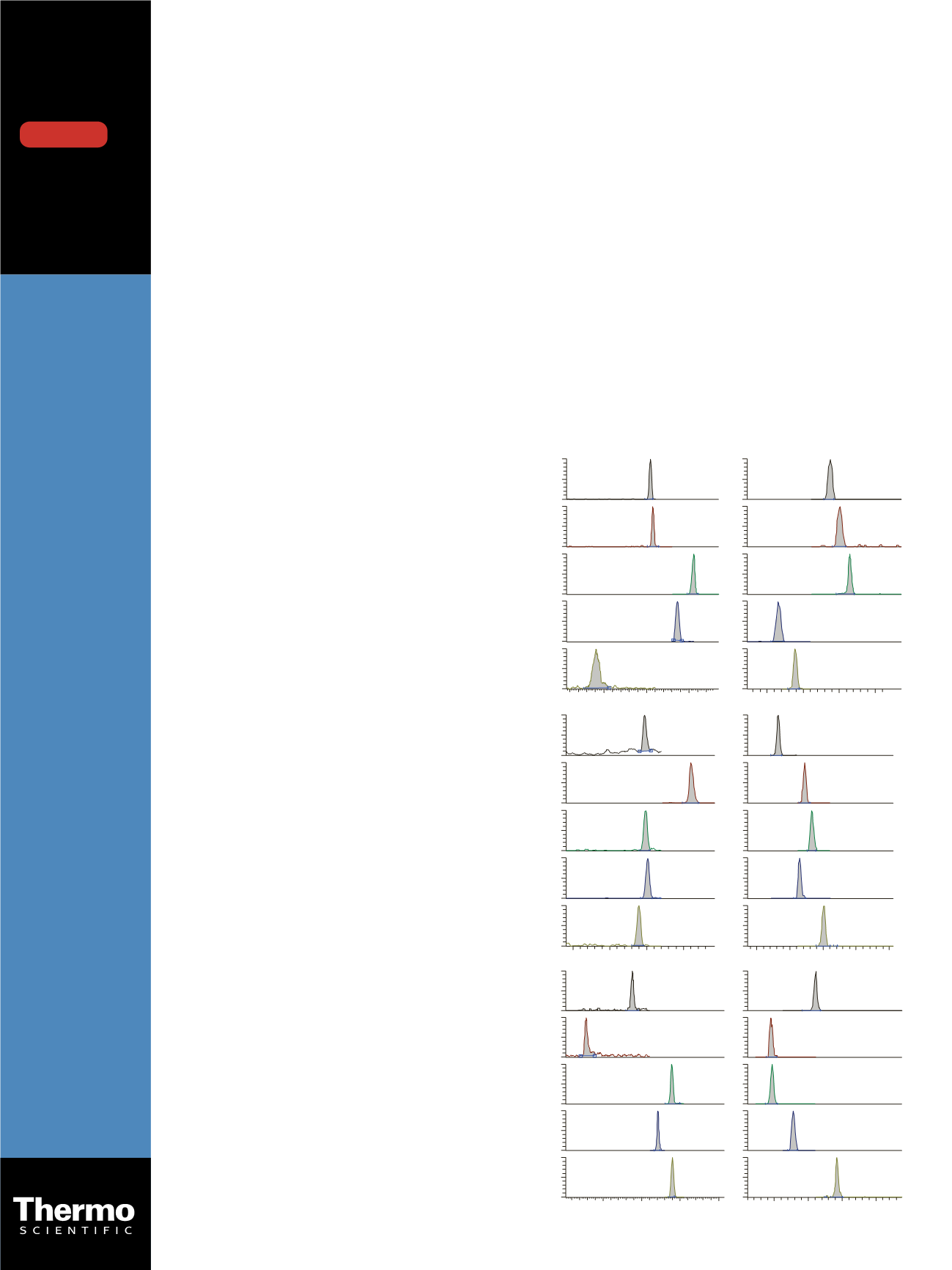

Screening and Quantification of Multiple
Drugs in Urine Using Automated Online
Sample Preparation and Tandem
Mass Spectrometry
Barbora Brazdova, Marta Kozak, Thermo Fisher Scientific, San Jose, CA
Introduction
Liquid chromatography-mass spectrometry (LC-MS) is a
sensitive, accurate, and precise technique applied in clini-
cal research for the analysis of a large number of com-
pounds and metabolites from various drug classes, such
as antidepressants, hypnotics, stimulants, cardiacs, and
antihistamines. Thermo Scientific Transcend system pow-
ered by TurboFlow™ technology provides an alternative
separation technique for complex biomatrices, simplifying
sample preparation, increasing LC-MS/MS sensitivity, and
reducing ion suppression.
Goal
To develop a fast and efficient LC-MS/MS method using
Thermo Scientific TurboFlow technology for the analysis
of 30 drugs and metabolites in urine.
Experimental
Sample Preparation
Eight internal standards were used in the study for the
corresponding compounds: nicotine-d4, cotinine-d4,
midazolam-d4, diphenhydramine-d3, promethazine-d3,
norlfuoxetine-d6, chlorpromazine-d3, and fluoxetine-d6.
For the other compounds, the internal standard with the
closest retention time was assigned.
Human urine samples (100 µL) were diluted with
100 µL of methanol containing the internal standards in
concentrations of 100 ng/mL. The samples were vortexed
and centrifuged. Then, 10 µL of the supernatant was
injected onto the TurboFlow column.
HPLC
HPLC analysis was performed using the Transcend™
system with a TurboFlow Cyclone MAX column
(0.5 x 50 mm) and a Thermo Scientific Hypersil GOLD
PFP analytical column (100 x 2.1 mm; 5 µm). Total analy-
sis time was 9 minutes.
Mass Spectrometry
MS analysis was carried out on a Thermo Scientific TSQ
Quantum Access MAX triple stage quadrupole mass
spectrometer equipped with a Thermo Scientific Ion Max
source and an electrospray ionization (ESI) probe. Two
selected reaction monitoring (SRM) transitions with scan
times of 10 msec were collected for each analyte.
Results and Discussion
Quantitation of 30 drugs in urine was performed in 9 min-
utes with a calibration range of 1-1000 ng/mL for
14 compounds, 5-1000 ng/mL for 9 compounds,
10-1000 ng/mL for 5 compounds and 50-1000 ng/mL for
2 compounds. Figure 1 shows the chromatograms of the
lowest calibration standard. Table 1 displays the calibration
ranges and method precision for all analyzed drugs.
Application
Note: 512
Key Words
• Transcend
System
• TSQ Quantum
Access MAX
• ToxID Software
• Clinical Research
Figure 1: Chromatographs of the lowest calibration standard.
2
3
4
RT: 3.09
RT: 3.14
RT: 4.11
RT: 3.72
RT: 1.81
3.0
3.5
4.0
4.5
RT: 3.87
RT: 4.01
RT: 4.15
RT: 3.15
RT: 3.38
Mirtazapine
Venlafaxine
Sertraline
Citalopram
Cotinine
Paroxetine
Norfluoxetine
Fluoxetine
Topiramate
Trazodone
2.0
2.5
3.0
3.5
RT: 2.97
2.46
2.16
RT: 3.60
RT: 2.99
2.17
RT: 3.01
RT: 2.90
3.0
3.5
4.0
4.5
5.0
RT: 3.65
RT: 4.00
RT: 3.32
RT: 3.72
RT: 3.82
Pheniramine
Diphenhydramine
Metoprolol
Doxylamine
Lidocaine
Chlorpheniramine
Prometazine
Hydroxyzine
Diltiazem
Verapamil
2
3
4
5
Time (min)
0
50
100
0
50
100
0
50
100
0
50
100
0
50
100
0
50
100
0
50
100
0
50
100
0
50
100
0
50
100
0
50
100
0
50
100
0
50
100
0
50
100
0
50
100
RT: 2.76
RT: 1.56
2.92
RT: 3.78
RT: 3.42
3.5
4.0
4.5
5.0
RT: 4.11
RT: 3.44
RT: 3.46
RT: 4.42
RT: 3.80
RT: 3.78
Chlorpromazine
Nicotine
Phenteramine
Orphenadrine
Dextromethorphan
Promazine
Midazolam
Mesoridazine
Cetirizine
Trifluoperazine
DOWNLOAD


















